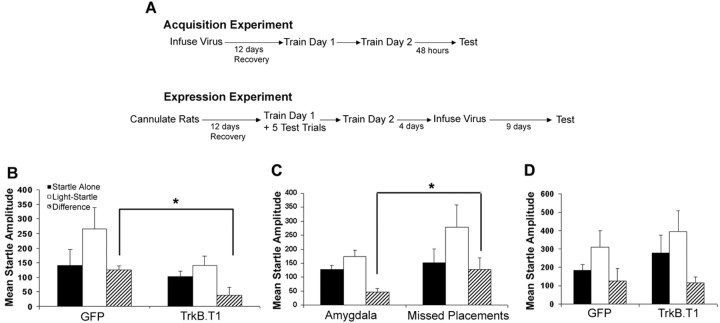Figure 8.
Effect of lentiviral induced expression of TrkB.T1 in the amygdala on fear conditioning as assessed by fear-potentiated startle. A, Outline of behavioral paradigms for acquisition and expression experiments. B, Filled bars represent startle response to startle-alone trials, white bars represent startle response to light-startle trials, and hatched bars represent difference scores. Mean startle amplitude ± SEM on startle-alone trials, light-startle trials, and the difference between the two are shown for animals receiving lentivirus infusion into the amygdala. Mean difference scores of lenti-TrkB.T1-infused animals were significantly lower than difference scores of lenti-GFP-infused animals (t test; *p < 0.05). C, Anatomical specificity of TrkB.T1. Mean startle amplitude ± SEM on startle-alone trials, light-startle trials, and the difference between the two are shown for animals receiving infusion of TrkB.T1 into the amygdala or areas outside the amygdala (missed placements). Mean difference scores for missed placement animals were significantly higher than difference scores of animals infused with lenti-TrkB.T1 into the amygdala (t test; *p < 0.01), demonstrating that the virus must be present within the amygdala to impair fear learning. D, Effect of amygdala infection with lenti-TrkB.T1 on the expression of fear-potentiated startle. Animals were trained, infected, and tested as in A. When TrkB.T1 virus is present during expression, but not acquisition, of fear learning, there is no difference between fear-potentiated startle with lenti-TrkB.T1 animals compared with lenti-GFP animals. An ANOVA with repeated measures showed a significant fear-potentiated startle effect-by-trial type but no trial-by-group interaction (ANOVA; p ≤ 0.05).

